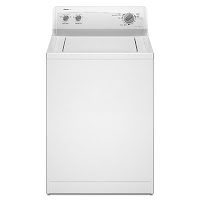There are a couple things that control the water coming into your washer. The first thing is going to be the water inlet valve. Basically how this works is you set the washer to fill with either hot, warm or cold water. When you turn the timer on, the temperature selector switch is going to tell which valve to open and let the water in. The timer only says it needs water, the temperature selector switch controls which valve lets it in. Basically the water valve is going to get 120 VAC, the solenoid will open and water will flow.
Now, if you push the timer knob in and the water stops flowing into the washer you have a different problem than what we just went over. This check is going to bring your attention to the pressure switch and the pressure switch hose. The pressure switch is going to be whats attached to the load size knob. How this works is, as the washer fills with water, air gets trapped inside the pressure switch hose. As the water level rises the pressure inside the hose becomes greater. So if you set the washer to a small load, it only takes a little pressure inside the hose to tell the pressure switch to cut the water off and tell the timer to agitate. If you set the load size for a large load, it will take a lot more pressure for the pressure switch to cut the water and tell the timer to move on. The pressure switch hose is attached to the bottom of the wash tub and runs up and connects to the pressure switch.
Let's say you overloaded your washer and it was banging around and you didn't catch it right away. You hear the machine going nuts, run down fix the load so its balanced and bounce. The washer still has to go through a rinse cycle or two. Because your machine was off balance and shoot violently, it could have ripped off the pressure switch hose that's attached to the bottom of the tub. Now air cannot be trapped inside the tube and your pressure switch is not going to have any idea how much water is in there.
Sometimes the a hole can develop in the hose from rubbing on the frame somewhere over years of use. If that happens that will leave out the pressure and you'll overflow your washer. If you have a problem with the switch or hose, the water will shut off to the washer simply by pressing in on the timer knob.
Please make sure you watch the video on this page. This is me explaining what I've gone over here in this article. Plus you get to see how to troubleshoot each part on your washer so you'll be able to tell if the hose is bad, or if the valve is bad and how to diagnose each part the controls the flow of water in your washer.
The last thing you want to have is a washer that overflows, but if you did and that's what brought you hear, I hope I was able to help you solve your problem and point you in the right direction getting you washer back up and running like it should be.
Be sure to give the video a "Thumbs UP" hit the "LIKE" button. Leave some comments either on this post or on the videos main page. I will do my best to answer your questions. Thanks for taking the time to read this and good luck with your Appliance Repair!
